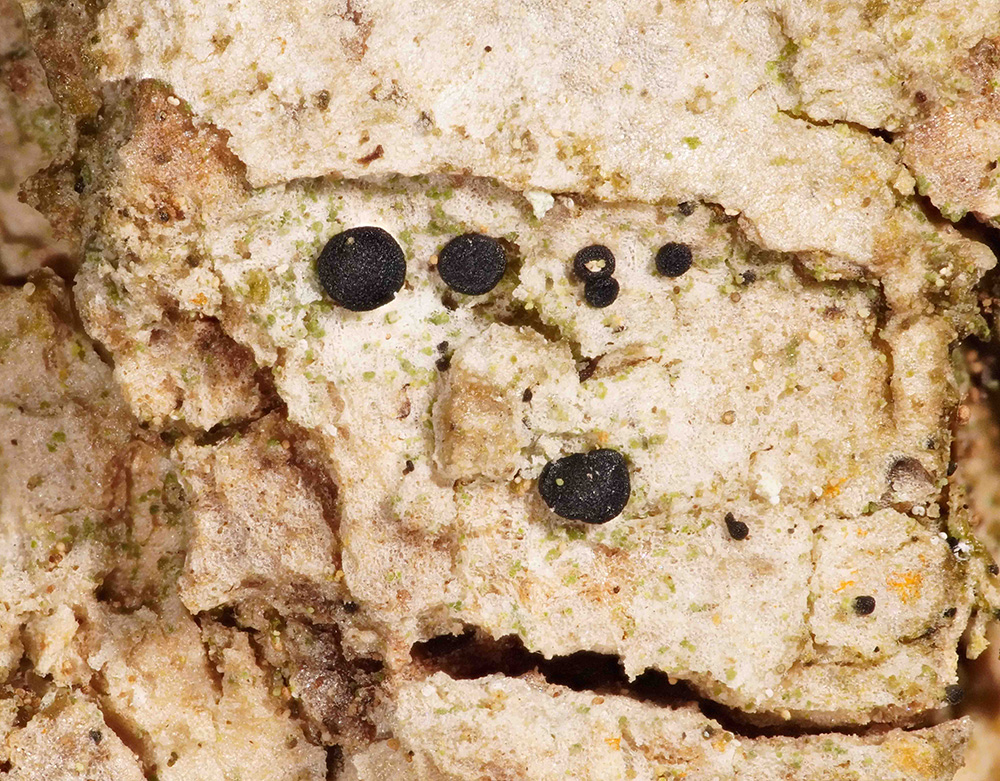Perfect protection – melanins are particularly important for lichens
Botanische Staatssammlung München & Genomics Core Facility
Munich, 2024-09-06
New genome analyses show: A crust-like miniature dot lichen recently discovered in Bavaria shows lots of ability to protect itself from the sun and herbivores. An international team of SNSB researchers found certain genes in the sequenced lichen genome that are responsible for the production of melanins. As in humans, these are able to absorb and reflect UV light as a protection against harmful solar radiation. The results of the study were recently published in the scientific journal Genes.
The dot lichen Toniniopsis dissimilis was only recently discovered and scientifically described as a new species in the Allgäu Alps. Like almost all lichens, it produces so-called secondary lichen compounds. Little is known about the function of these metabolic products. However, some of them, produced by the so-called polyketide synthases, are known to be ecologically and pharmaceutically important, for example melanins. An international team of researchers from the Bavarian State Collections of Natural History (SNSB) has now found evidence in the genome of Toniniopsis dissimilis that an unusually large proportion of its polyketide synthases are likely responsible for the production of melanins. As in human skin, these mostly dark brown to black pigments protect lichens from a harm of excessive sunlight.
The researchers were particularly surprised by the large number of polyketide synthases involved in melanin biosynthesis in Toniniopsis dissimilis: “Although Toniniopsis dissimilis has by far the lowest number of so-called type 1 polyketide synthases compared to other analyzed lichen genomes, however two thirds of these are involved in the production of melanins. This suggests a particular importance of melanins for this lichen species, which grows in light forests and is an indicator of a healthy, diverse and natural tree population. In such environment, there is quite strong sunlight at times, so melanins probably help to protect from the sun,” says Julia Gerasimova, the first author of the study, as she explains the results. The lichenologist now works at the Senckenberg Research Institute and Nature Museum in Frankfurt.
The purpose of melanins is presumably not limited to protection against harmful UV radiation. These pigments are also known to repel herbivores due to their unappealing taste. “In such near-natural forests, where Toniniopsis dissimilis is commonly found, there is a high number of animals that also feed on lichens, such as snails and mites. Preventing them from being eaten is therefore vital. Thus, the melanins probably also have the important role in reducing feeding pressure”, says Andreas Beck, botanist and mycologist at the Bavarian State Collection for Botany of the SNSB (Botanische Staatssammlung München).
The genome of Toniniopsis dissimilis was sequenced by the SNSB’s genomics laboratory, the Genomics Core Facility. The newly sequenced genome can be used as a reference for further research on lichens. These studies once again will contribute to a better understanding of lichen metabolism and its great hidden potential.
Publication:
Gerasimova, J.V.; Beck, A.; Scheunert, A.; Kulkarni, O. De Novo Genome Assembly of To-niniopsis dissimilis (Ramalinaceae, Lecanoromycetes) from Long Reads Shows a Compara-tively High Composition of Biosynthetic Genes Putatively Involved in Melanin Synthesis. Genes 2024, 15, 1029.
https://doi.org/10.3390/genes15081029
Scientific Contact
PD Dr. habil. Andreas Beck
SNSB – Botanische Staatssammlung München
Menzinger Str. 67, 80638 München
Tel.: 089 17861 266
E-Mail: beck@snsb.de
Dr. Om Kulkarni
SNSB – Genomics Core Facility
Menzinger Str. 67, 80638 München
Tel.: 089 17861 206
E-Mail: kulkarni@snsb.de



